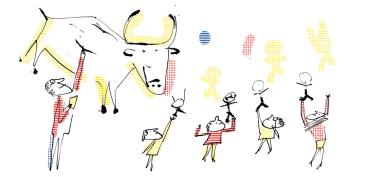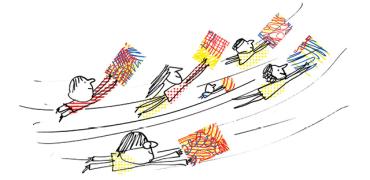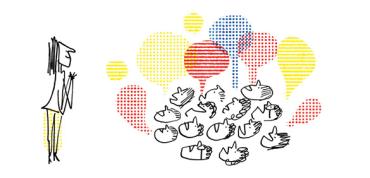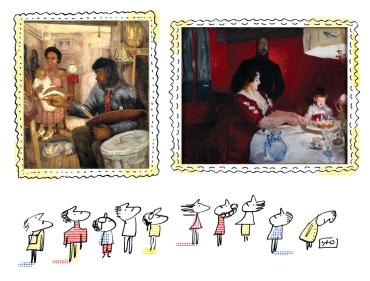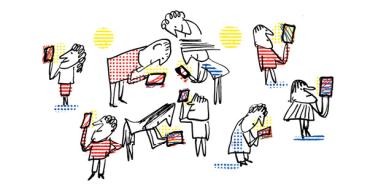Humans have made pictures since the beginning of time. Before any record of written language, people painted. Take, for example, ancient walls covered in drawings, like those found in the Lascaux caves in France created by Paleolithic humans estimated to have lived as far back as 16,000 BCE.1
Perhaps image-making is a basic instinct. Given the chance, children draw and paint as soon as they can hold the tools—certainly before they can easily talk. Early on, they make what seem to adults like random marks, but soon enough, surveys of children’s drawings show a universe of schemes they develop for representing what they’ve seen.
“What they’ve seen” is a compilation that begins as soon as infants can focus. It’s another instinct for all sighted children—they figure things out by looking. Tiny babies quickly recognize their parents and siblings and figure out that each one attends to them in a different way. They recognize that different expressions mean different things, a smile different from a worried look, for example. We can see their awareness in their expressions. But this is just the beginning. Babies continue to search their worlds with their eyes, and as they grow, their visual insights build. Dogs are differentiated from cats, and different sizes and shapes are accommodated within the overall categories. By the time they are 3 and 4, all are adept at figuring out a great deal from looking around.
This “figuring out” is referred to by the cognitive scholar Rudolf Arnheim as “visual thinking.” In his book of that name, he details the instantaneous and productive processing by the brain of what the eye takes in.2
Caregivers and early childhood educators make use of the curiosity, desire to know, and visual acuity of children to provide much of the basis for language and other learning. Playing on their incessant looking, the people around them who know to do so name what a baby’s gaze seems to rest on. They chat with the child about what happens during the course of days—while eating, taking walks, playing, bathing, and so on. They narrate during wanders through parks, zoos, and stores, connecting what is seen and experienced to words and sentences. They introduce illustrated books that captivate children’s attention and provide a useful bridge from seeing to talking to reading.
When books and reading aloud are in the mix of resources made available, illustrations help children learn language by several means. They offer a parallel version of the story told in words, one that can be decoded using a child’s visual skills. They allow a child to see what words mean as they are read aloud, anchoring sounds and words in images. Illustrations often provide nuances and details not covered in the text, enriching the content of the minimal written story.
The situations and phenomena depicted as well as described in words give children bite-sized slices of the complexity of the world they see around them, aids to comprehension of what is taken in overall. As children focus on what they see as they listen, the seeing-hearing combination reinforces their gradually building vocabularies and ability to communicate.
In other words, thoughtful caregivers know they are responsible for creating visual and language-rich environments that stimulate and support early learning. The richness, however, varies from family to family and is complicated by many factors, such as demographics, socioeconomic status, and the language spoken by parents and caregivers. The differences are significant. Children who are deprived of resources and conversation enter school at a disadvantage.3
Diane Zimmerman—a veteran educator, child speech pathologist, writer, and retired superintendent from the Old Adobe Union School District in California—remarks:
Most teachers in the early grades believe in developmental learning. During the last decades, however, the emphasis has so shifted to text-based instruction, even in kindergarten, that we forget to capitalize on the natural ability of children to look, listen, and talk about their environment. By the time they enter school, children have demonstrated a natural ability to direct their learning toward what helps them make sense of the world. Children need to keep looking—and looking and talking—all through the middle years, a time of great cognitive creativity and drive. The brain has been primed to weave together all manner of learning to create deep understandings of the world. This developmental period signifies an emergence from dependency, with children becoming more independent while continuing to broaden their knowledge and skills. The ease of finding images, sounds, and videos on the internet has opened a way for the teacher to bring this rich visual and auditory world, free of text, into the classroom, and it’s a mistake not to do it.4
Guided looking, even done informally, has a huge impact on early childhood preparation for elementary school and is an effective way to address learning inequities. Why, therefore, does it play such a small role in schooling?
Introducing Works of Art
This is a question that occupied me during my long career working in art museums, where the adults, once visually acute 4-year-olds, arrive wanting basic help finding meaning in the diverse images on view. Since they were adept at figuring things out from looking when they were little, what happens to decrease this remarkable visual literacy? I think Zimmerman hits the nail on the head: “The emphasis has so shifted to text-based instruction, even in kindergarten, that we forget to capitalize on the natural ability of children to look, listen, and talk about their environment.”
For the past 30 years, I’ve been on a mission to maintain this literacy in young people and, more specifically, to get art into the lives of all children. But why art? Because works of art pose approachable problems that kids can unravel using existing visual and cognitive skills. While illustrations have to be pretty straightforward to communicate effectively, not so art; the vocabularies used to convey meaning in art are varied, and most are demanding. Art images are ambiguous and multilayered, providing fodder for both thinking and the ongoing growth of the language needed to convey complexity.
I’ve long known that there is only one possible way to integrate art into young people’s lives: working with teachers and schools. To be meaningful to our educational partners in schools, however, my colleagues and I had to go beyond what we were doing in museums. At the Museum of Modern Art (MoMA) in New York City, where I was the director of education for a decade, we actually found that our teaching engaged visitors (including kids) and was enjoyed by them, but it didn’t accomplish its other intentions: reviving the skills people had when they entered school. We knew we needed new strategies to help museum visitors in ways they wanted. But importantly, we needed methods that would prove powerful in ways that would convince teachers and administrators to add something to an already packed curriculum.
The result of much effort was Visual Thinking Strategies (VTS). VTS is a program that enables teachers to use specific strategies as part of their existing curriculum to develop students’ skills of observation, social interaction, and language development. It evolved over the course of more than a dozen years of field research to see if and how it worked—what teachers and students of all ages experienced, how teachers used it, and what growth it produced. Cognitive psychologist Abigail Housen and I led the team, and the story of that work is described in my book Visual Thinking Strategies: Using Art to Deepen Learning across School Disciplines.
We first drafted VTS during the 1990–1991 school year, when I was still at MoMA. Housen and I hoped the teaching would jump-start the skills museum visitors thought they lacked, which limited their pleasure looking at art. We turned to schools to test our lessons, collaborating with teachers who would let us visit their classrooms to get some sense of the impact, and who would let us collect data from students over time, which is hard to do in museums because visits are usually infrequent and informal.
Given our intention to revive viewing skills—another way of saying “visual literacy”—we relied on data to help us start the learning process. For more than 15 years, Housen had been studying how people think when looking at art. She could describe how the brain processed observations and how the cognition changed as experience grew. We used this as the basis for creating lessons that enabled students to put existing skills—the ability to observe, to talk, and to make sense of observations, for example—to work as the first step in the teaching/learning process.
We also knew what skills were within reach. We could therefore add challenges appropriately to increase students’ ability to find meanings in art and other images. We watched and documented what happened and folded what we learned into extensions of the original lessons as well as into frequent revisions.
Sparking Discussion
VTS is a discussion-based approach that supports teachers in introducing art images for students to consider and discuss. Finding appropriate images—with uncomplicated, recognizable narratives for little ones, and more complex ones for older students—is easy, particularly given search engines like Google Images. All one needs to do is think about what stories would engage and excite a particular class of kids. Two images that work well for all ages are shown below: Palmer Hayden’s “The Janitor Who Paints” and John Singer Sargent’s “The Birthday Party.”
Discussions work best in a group of peers, as opposed to situations where participants have unequal expertise regarding a subject. While it is a challenge to hear from all who want to speak, even classes of 30 or more students can engage in a reasonable discussion. To create an opportunity for all to contribute, we recommend leading several discussions in a row, roughly 12 to 15 minutes for each.
To begin the process of discovery about an unfamiliar topic, play to students’ ability to make observations by choosing images like these two that depict at least some familiar and recognizable people, places, things, and activities. Search for images that contain enough that is familiar to prompt many observations. The two examples on the following page provide some clues as to what works. For example, one shows a man doing something—the paint brush, familiar to many, suggests exactly what he’s up to—with a woman and child sitting nearby. Very few clues suggest what he’s painting, however, and many other aspects of the setting, while recognizable, provoke a certain amount of wonder. Young children spend more time identifying what they see, and it’s great when a teacher can supply the missing words—“easel,” for example, or “palette”—even when the thing itself is recognized. They enjoy puzzling about what they think the man has already depicted in the corner of his canvas and why the lady is so dressed up. Older students spend time with identification too but concentrate on debating the odder details of the location—what they can learn from the trash can, the cleaner’s tools, the sprinkler, and the undue prominence of the clock.
In the other painting, the cast of characters and event can be figured out fairly easily, but what’s going on with the male figure’s face? The missing features, red interior, and dark elements contribute to a sense of mystery. Younger people focus on the birthday, the child and its gender, what the female figure is doing, and enumerating what’s on the table. Older students will also take inventory of what’s to be seen but are likely to concentrate on the darker possibilities in the painting, triggered by the man and how he looms over the action in a slightly murky way.
As you can surmise from these summaries of what students discuss, appropriate images not only depict elements children quickly recognize, but also contain aspects that are up for deliberation—ones that provoke a range of opinions. You want to make students go beyond what is obvious to them and gain practice at deeper thinking. You want, therefore, to find images that have elements that are debatable, material to chew on so to speak. You are preparing them to become adept at probing for a variety of meanings and different levels of meaning, useful in subjects across disciplines. It’s what scientists and historians do: they make observations and then start to ruminate on the variety of conclusions that might be drawn.
We recommend starting VTS using art, but images of other sorts work as long as they follow certain guidelines, summarized here:
-
Choose works of art depicting subjects of interest to your students. For young students, subjects that work well include children playing, parents and children interacting in familiar ways, and animals doing something interesting. Narrative content—stories—works for all ages; it’s the specific story and its complexity that varies according to age. The older the students, the more crucial it is to pick stories that interest them, ones that relate to their concerns and values at the present moment.
-
Use familiar imagery given the existing knowledge of students and considering their varied life experiences as well as what’s been covered at school. The students need to recognize enough of what is presented immediately to begin talking.
-
Choose accessible story lines—narratives with understandable meaning—thinking about the specific group of students you are teaching. What’s meaningful to preschoolers is quite different from high school students. And where and how your students live are other factors that determine what they recognize, and what they both can and want to deal with.
-
Allow for some ambiguity in the image and room for interpretation. While you want to engage students quickly, you also want to keep them looking. This requires ideas that will take a few minutes to puzzle through, stories whose meanings will deepen with a bit of time and collaborative thinking, and subjects that allow room for multiple ideas to be valid.
In using VTS, we suggest teachers steer away from images that are dense, abstract, murky, macabre, or scary. It’s not that children cannot deal with these in some ways, but we recommend giving them images that allow them to compute meanings that add to their trove of memories in positive ways. Nudes are illogical choices too, in order to respect the values of children’s home environments, very diverse in the contemporary world. There is enough time later for the broader range of options our very visual world produces. The internet makes it easier than ever to find and use images, and the array to choose from is staggering.5
Allow a few moments of silent looking at the image chosen before beginning the discussion. Make it a task with specific directions if you need: for example, encourage students to look from top to bottom, then side to side, and to look for big details and small ones.
Pose specific questions to motivate and maintain the inquiry. Through our research and testing, Housen and I found that it only takes three specific questions to facilitate a productive discussion, and we suggest using them just as we’ve worded them below. Students then have a chance to memorize them and make use of them in many different kinds of inquiries, even on their own. (You may also find the pattern of questions useful as you teach other exploratory lessons.)
- Start with: “What’s going on (or what’s happening) in this picture?” Ask this only once, to get the discussion started. With very young children, consider starting with: “What do you see in this picture?” Or “What do you notice?”
- Follow any comment that contains an inference (an idea that is open to interpretation, different from a straightforward observation) by asking: “What do you see that makes you say that?”
- Before each new student comments, ask: “What more can you find?” Even when you are calling on a student whose hand has been in the air, keep positing the notion that there is always more to be found. VTS is an exercise in thinking reflectively, not coming to conclusions quickly.
Many teachers talk about the impact of the questions, and most argue in favor of memorizing them. Rachel Zender teaches sixth grade in Spokane, Washington, and she makes that case well:
The teacher’s understanding and knowing the questions is essential. When they haven’t been memorized, and the teacher seems to be trying to remember what’s next, the discussions can feel forced and unnatural for the kids. Once I really had them down, I always knew what to do next, and I was free to be more present, and the kids could see that.6
Asking these questions activates the discussion, but to fully nurture learning, you need to facilitate the discussion that follows. The guidelines below are the result of many years of studying what makes learning happen, a combination of action on the part of the student and support from the teacher.
- Listen carefully to catch all a student says. If you don’t quite grasp it at first, ask him or her to repeat it. If you still don’t understand, ask for help: “Can you add more words to help us understand?” If you can’t find what the student sees, again ask for help: “Can you show us what you’re seeing?” If students struggle for language (it can happen with very young children and those for whom English is not their primary language, among others), let them come to the image and point.
- Point to all observations as students comment. This is a “visual paraphrase” that says you’re following what they mention. Point again to what’s been mentioned as you rephrase their ideas.
- Paraphrase each comment, no matter how short, taking a moment to reflect if you need a bit of time to find the words to do so. Show you understand the student’s meaning as you respond.
- Link related comments whether or not students agree or disagree or build on one another’s ideas.
- It is important to remain neutral, treating everyone and each comment in the same fair and open way. VTS isn’t about finding right answers; it’s about observing and thinking about what one sees as part of an open-ended discovery.
Conclude by thanking students for their participation. Tell them what you particularly enjoyed. Suggest they share other ideas with someone sitting next to them if they didn’t get a chance to talk. Or let them write short statements about what they think is going on in an image. You can use these to help assess their writing ability—usually aided if a discussion precedes writing—as well as changes in their thinking.
No “Right” Answer
Switching from conventional teaching modes to one as different as VTS can create moments of discomfort, but most teachers enjoy this approach, especially watching all students participate with enthusiasm. And, again, even during the phase where teachers are learning the craft of rephrasing and linking students’ comments, our data, in the form of observations and teacher insights, show that all students grow in their ability to express themselves.
Students, too, accustomed as most are to discussions that are seeking correct responses, may be troubled at first by the openness of VTS, where many answers are correct and none are wrong, as long as they are backed up with evidence. Since art is intentionally ambiguous and open to debate, it’s a perfect arena in which to learn to explore without the pressure of finding the “right” answer.
VTS has been used at every grade level, from preschools to universities, including in medical education. The strategy remains as you just read it described above; what changes as students get older is the art—and increasingly, the use of images of other sorts, from photojournalism to historical and scientific—as well as your expectations of what will happen. Preschoolers talk about what they see and what interests them, as do high school students, though their interests are, logically enough, quite different.
Tracy McClure has taught sixth-graders in Petaluma, California, for years. She took to VTS quickly when she first started using the approach 10 years ago. A specialist in English language arts and writing, she thought that VTS applied to poetry might engage her students more than other methods she’d tried. After several years of using VTS with images and also adapting it for teaching poetry, her students recognized just how much it benefited them. In response to the question “How do you learn best?,” here are two typical answers from her students:
First student: “I learn the best when I work in a group. I can really learn because I get more than one interpretation about something. Hearing my peers’ interpretation of the subject might give me a new way of seeing or of solving something. I can’t learn as much working alone or in pairs because I can’t hear as many ways of thinking.”
Second student: “When I learn just about anything, I always like to hear people’s ideas first and then I add on to them. I am the kind of person who has to talk through things in order to learn them. Another thing that I do when I learn is, when I’m talking through it, I also get a picture in my head of what is going on in whatever I am learning at the time.”
These insights resonate in the work of many learning theorists. For example, Lev Vygotsky, a student of early childhood behavior, documented many young children talking their way through tasks as they figured out what they were supposed to do. As soon as language is available to them, he points out, children begin talking themselves into learning what they come to know.
It’s clear that this “talking through” hasn’t stopped working for the second student quoted above—and she’s hardly alone. Meaning-making is the task to be talked through in the case of VTS, and it’s a key aspect of cognition: VTS gives students the chance to engage their eye-mind connections, use their growing language ability to probe the visual complexities (and to do so with assists from peers), and in effect use art to help them learn to think. By way of extended discussions, children learn more and more about how oral language and communication work as well.7
Within a few years of testing VTS, our school data revealed that a set of roughly 8–10 hourlong discussions conducted in a sequence over several months had a measurable impact on students:
- They made more observations, which became more detailed and focused over time.
- They drew more inferences from these observations.
- They backed up increasing numbers of opinions with evidence.
- They speculated among multiple possible interpretations.
- They elaborated on early ideas and often revised their notions upon reflection.
In recent years, the need for fluency with these skills has increased in importance as schools prioritize problem solving. Teachers using VTS attest to witnessing the above changes, particularly in the first three categories, after only 8–10 discussions. Teachers also report they are likely to see these behaviors employed in other lessons, too, where observing, inferring, and/or providing evidence are needed. They often show up in students’ writing as well.
Another finding is the often-cited impact of discussions on social behavior. VTS discussions engage all students, including those usually reluctant to speak up. Discussions have a civility sometimes missing in other classroom exchanges, and this carries over to other collaborations, whether in preschool or in higher grades. Students steadily develop confidence in their own voices and in the validity of their opinions. The importance of such social and emotional growth has increased in recent years as schools have assumed more responsibility for developing all aspects of student potential, not just academic achievement.
Although schools today tend to turn art-making over to the few specialists left to visit classrooms where it is often proudly displayed, in the past, art played a more central role in people’s lives. It was more than just décor, for it often embodied and conveyed deeply felt matters—ideas and information that helped people know who they were and from whence they came.
Art objects connected them to their gods, marked the passage of time, honored those who came before them, and manifested essential truths. Much art of the past was sacred, and those works that tend to live on do so only because generation after generation recognizes the inherent value of art in aiding our understanding of the human condition. VTS allows teachers to bring this heritage into the lives of all children and to do it while respecting the many demands on their time.
Philip Yenawine is a cofounder of Visual Thinking Strategies (VTS) and the Watershed Collaborative, established to increase access to VTS, and the former director of education at the Museum of Modern Art. Parts of this article are excerpted with permission from his books Visual Thinking Strategies: Using Art to Deepen Learning across School Disciplines (2013) and Visual Thinking Strategies for Preschool: Using Art to Enhance Literacy and Social Skills (2018). Both titles are published by Harvard Education Press.
Endnotes
1. See “Lascaux Cave Paintings: Discover, Layout, Meaning, Photographs of Prehistoric Animal Pictures,” www.visual-arts-cork.com/prehistoric/lascaux-cave-paintings.htm.
2. R. Arnheim, Visual Thinking (Berkeley and Los Angeles: University of California Press, 1969).
3. B. Hart and T. R. Risley, Meaningful Differences in the Everyday Experience of Young American Children (Baltimore, MD: Paul H. Brookes, 1995).
4. D. Zimmerman, interview with author, 2017.
5. For VTS training online and access to images for all grade levels, see https://watershed-1.herokuapp.com. For images that deal with current events and history, see Michael Gonchar, “40 Intriguing Photos to Make Students Think,” New York Times, September 22, 2016, www.nytimes.com/2016/09/22/learning/40-intriguing-photos-to-make-studen….
6. R. Zender, interview with author, 2012.
7. L. S. Vygotsky, Mind and Society: The Development of Higher Psychological Processes (Cambridge, MA, and London: Harvard University Press, 1978).

